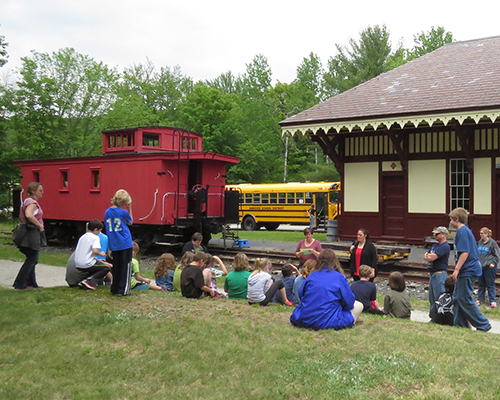
June 4 was an exciting and busy day in the town of Andover as the young and the old came together for a visit at the Potter Place Railroad Station. The young were the fourth graders from the towns of Webster, Salisbury, and Andover. The old were the various buildings and artifacts which comprise the Andover Historical Society Museum.
As the children arrived from the three towns at staggered intervals, they were divided into three groups, with each group taking its turn visiting a different area of the museum. Group One began its tour at the railroad station, where they were greeted by volunteers Pat Cutter and Rita Norander.
A brief history was given of the station and the coming of the railroad to Andover and how important its arrival was to the welfare and development of the town. The children enjoyed seeing and learning about the dugout canoe which was discovered in one of Andover’s ponds and which became the museum’s first artifact. The students were given time to explore the station on their own, and the stationmaster’s office, with its big window and clear view of the track, was of special interest to them.
The children were given a little background information about Richard Potter, for whom the village is named, and they were shown a picture of his house. This was followed by a walk across the tracks to see the original site of Potter’s house and the little cemetery where Richard and his wife Sally are buried. The cellar hole of “Potter’s place” has recently been turned into a secret garden, with many plants and flowers and a few benches, all of which are surrounded by the beautiful stone work of the cellar. The students were enthralled and delighted with the enchanting, secret garden.
Group 2 began its tour at Emmons Store, which is across the street from the railroad station. They were greeted by volunteers Suzy Norris, Gail Richards, and Nancy Tripp, who gave a brief history of the building before the children were allowed to browse on their own. They enjoyed seeing the general store display, which is set up as it would have looked in years gone by; the post office, with its original mail boxes; and the numerous other items of interest from the past, such as tools, dishes, appliances and equipment, clothes, quilts, and much, much more.
The students especially enjoyed trying on the old hats and eye glasses, followed by a peek at themselves in the mirror. Before leaving, they had fun playing a guessing game where they were shown an item from the museum’s collection and they tried to guess what its use might have been.
Group 3 participated in two shorter activities, beginning with a visit to the big red caboose. They learned more about trains in general and specifically about cabooses and their vital role and place in a train’s lineup.
Each caboose had a lookout post atop its car, called a cupola, which allowed workers to see the length of the train ahead and possibly to detect any potential trouble spots. It also allowed the workers to see behind the train, should another unexpected train be approaching from that direction. If there were a problem of any kind, the person in the caboose would send up a warning flare to alert others of the danger.
The caboose was sort of the “home base” for the entire crew of the freight train, and the same crew always kept the same caboose on whichever train they were working. Their personal things could be kept there, and if necessary, this is where they would spend the night.
The students had fun exploring the inside of the caboose and getting a feel for what life might have been like working aboard a train and riding in the caboose.
Next, Group 3 walked to the grassy, shady area of the museum grounds and participated in some old-fashioned children’s games. A good time was had as they enthusiastically took on the challenge of the grain sack race, the three-legged race, and carrying an egg in a spoon. Helping out with the caboose tours and the children’s games were Chris Norris and Tim Norris.